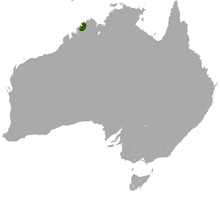Kimberley rock kangaroo
| Kimberley rock kangaroo | ||||||||||||
|---|---|---|---|---|---|---|---|---|---|---|---|---|
| Systematics | ||||||||||||
|
||||||||||||
| Scientific name | ||||||||||||
| Petrogale burbidgei | ||||||||||||
| Kitchener & Sanson , 1978 |
The Kimberley rock kangaroo ( Petrogale burbidgei ) is a species of kangaroo from the genus of rock kangaroos ( Petrogale ). It lives in a small area in northwestern Australia and was not scientifically described until 1978 . The specific epithet honors the biologist Andrew Burbidge .
features
The Kimberley rock kangaroo, together with the dwarf rock kangaroo, is the smallest species of rock kangaroos and the kangaroos at all. It reaches a head body length of 29 to 35 centimeters, a tail length of 25 to 32 centimeters and a weight of 1 to 1.4 kilograms. Their fur is soft, it is colored gray-brown on the back, the underside is lighter. There is a black tassel at the tip of the tail. As with most kangaroos, the back legs are longer and stronger than the front legs.
Distribution and way of life
This species of kangaroo lives in Australia . It lives in a small area in the Kimberley Plateau in northern Western Australia and some offshore islands of the Bonaparte Archipelago. Their habitat are rocky sandstone regions.
These kangaroos are nocturnal and sleep in crevices or caves during the day. At night they go in search of food, for which they go to tree-lined areas. Your diet should consist of leaves, fruits and buds.
Danger
Little is known about the threats to the Kimberley rock kangaroo. It is possible that bushfires and hunting by imported cats represent dangers. The IUCN lists them as " near threatened " due to their small distribution area .
literature
- Ronald Nowak: Walker's Mammals of the World. Johns Hopkins University Press, Baltimore 1999, ISBN 0-8018-5789-9
Web links
- Information and photo at rootourism.com
- Petrogale burbidgei onthe IUCN Red List of Threatened Species . Retrieved May 22, 2009.
